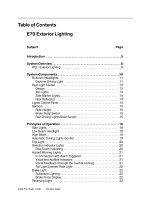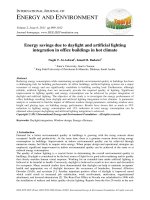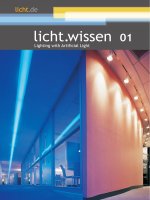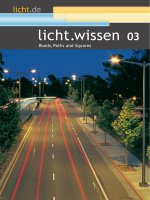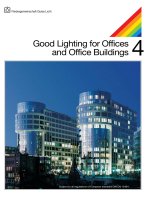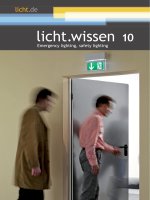Licht wissen 10 Emergency lighting safety lighting
Bạn đang xem bản rút gọn của tài liệu. Xem và tải ngay bản đầy đủ của tài liệu tại đây (6.6 MB, 52 trang )
licht.wissen 10
Emergency Lighting, Safety Lighting
Free Download at
www.all-about-light.org
2
01
licht.wissen 10 Emergency Lighting, Safety Lighting
Light and safety are closely linked. General lighting – lighting that is dependent on regular
mains electricity – is widely understood by operators and users and documented accord-
ingly in the relevant regulations and guidelines. In the case of mains-independent emer-
gency lighting – lighting which is activated only after a fall or failure of mains voltage – the
same level of understanding cannot be expected.
Understanding emergency lighting is made more difficult by the multiplicity of standards,
stipulations and guidelines relating to it. As a result of the harmonisation of national and in-
ternational norms, significant standardisation has taken place here in recent years – espe-
cially with regard to terminology. Emergency lighting is the umbrella term. It denotes lighting
that is activated when general lighting fails. Where emergency lighting is used to allow a
building to be evacuated safely or to enable potentially hazardous work operations to be
safely terminated (in the event of a mains power failure), it is referred to as safety lighting.
That is the main topic of this booklet.
Under the German Occupational Health and Safety Act (ArbSchG), employers are required
to conduct a hazard assessment of all work premises and workplaces. Where this reveals
that a power failure and the resulting failure of general lighting would present a hazard
for employees, a safety lighting system needs to be installed. This booklet takes account of
occupational health and safety requirements as stipulated in the new technical workplace
regulations (ASRs) and the relevant rules of the employers’ liability insurance associations.
It also looks at the passages relating to safety lighting in building regulations and examines
the contents of lighting and electrical standards.
The development of the LED has radically transformed the products used for safety lighting.
The LED light source is going to pervade every area of emergency lighting.
In future, attention will need to be paid not only to this technological step change but also
to barrier-free escape routes and dynamic guidance systems. Technical regulation is increa-
singly international. Europe is (by necessity) growing together. The primary focus must
always be human needs and the primary purpose of safety lighting must be to help enable
human beings to evacuate areas safely in the event of a failure of artificial lighting.
Prof. Dr. Bruno Weis
3
Editorial
[Titel + 01] No electricity, no light: power
failures knock out lighting. In hospitals,
schools and places of assembly, mains-
independent emergency and safety lighting
needs to kick in immediately. It enables
buildings to be evacuated safely, facilitates
orientation and reduces risk of accident.
4
licht.wissen 10 Emergency Lighting, Safety Lighting
Emergency
lighting for safety
Page 6
Light
in a power cut
Page 8
Safety lighting
Page 10
Escape route
safety lighting
Page 12
Safety lighting
for work
premises
Page 16
Anti-panic
lighting
Page 20
Standby lighting
Page 21
Safety signs
Page 22
5
Escape sign
luminaires
Page 24
Luminaires for
safety lighting
systems
Page 26
Safety lighting
operation
Page 30
Application
examples
Page 34
LED
light source
Page 46
Standards and
ordinances
Page 48
Series of
publications,
Imprint
Page 50
6
licht.wissen 10 Emergency Lighting, Safety Lighting
Escape signs
A white stick man on a green background or a stylised
green man on a white background? There are two escape
signs currently in use. Which one is correct? Newly
installed emergency lighting systems should incorporate
the new sign (shown above), which complies with ASR
A1.3 and DIN 4844-2.
But the old escape sign (below) remains valid. licht.de
advises against mixing old and new signs in an existing
system.
03 04
OLD
02
7
[02 + 03] Every power failure presents haz-
ards. Sudden darkness triggers fear: the rea-
son for the blackout is unknown and people
have difficulty getting their bearings, espe-
cially those who are not familiar with the
building. This is why it is mandatory for many
buildings to be equipped with mains-inde-
pendent escape route signs and supplemen-
tary safety lighting.
A power outage can paralyse whole re-
gions: trams stop running, computers crash
and lights are instantly extinguished. In re-
cent years, two “extreme incidents” made
headlines in Europe. In late November
2005, masts carrying overhead power lines
in the Münster area collapsed under the
weight of snow and ice, causing a blackout
that lasted more than four days. On 4 No-
vember 2006, an event in the Emsland area
gave rise to a power outage that left large
parts of Europe without electricity for hours:
a high-tension cable was shut down to
allow a cruise vessel to sail down the Ems
River to the North Sea from the Meyer ship-
yards at Papenburg.
Most power outages are more localised,
however, and do not last for hours. Ger-
many has the best record in Europe for
maintaining a reliable power supply. But
even it registers a rising number of outage
incidents. On 8 March 2011, for instance,
the Bundestag and a number of govern-
ment buildings in Berlin had to manage
without electricity for nearly 12 hours; on 13
July 2011, around 600,000 people in and
around Hanover suffered a cut that left
them with no power for up to an hour and a
half. Power failures occur for a wide variety
of reasons: violent storms, high winds,
earthworks/excavation operations, fires and
system overloads are just five of 27 possi-
ble causes.
Safety lighting
No electricity means no lighting. This is
when mains-independent emergency light-
ing needs to kick in. In a building suddenly
plunged into darkness, panic can quickly
spread – especially if a large number of
people are present and some are not famil-
iar with the surroundings. A blackout in an
unknown place for an unknown reason trig-
gers fear.
Escape sign luminaires identify routes out of
a building, supplementary safety lighting
along escape routes facilitates orientation
and reduces risk of accident. Safety lighting
is a must. Where safety lighting is required
by law, responsibility for installing and main-
taining it resides with the operator of the
establishment; ensuring that a new or mod-
ernised installation complies with regula-
tions is the responsibility of the designer.
Failure to comply with the stipulations set
out in standards may be judged hazardous
building practice, which is an offence pun-
ishable under paragraph 319 of the German
Criminal Code.
Different rules
Despite harmonisation efforts, the rules
about where emergency lighting is required
still differ – in some cases from one part of
Germany to another but, in particular, be-
tween Germany and other member states
of the European Union (EU). Retailers in
Germany and Austria, for example, are only
required to install emergency lighting in
sales premises over 2.000 m
2
. Blanket re-
quirements are in place only in Belgium,
Finland and Sweden.
Compared to other European countries,
Germany has relatively few blanket require-
ments for emergency lighting. Moreover,
the thresholds above which emergency
lighting is mandatory are relatively gener-
ous.
What this means is that there are more
places where employee safety is not guar-
anteed in the event of a power failure. In
terms of emergency lighting standards
based on building regulations, Germany
lags behind most of the EU.
In some cases, obligations are imposed by
occupational health and safety regulations:
employers need to decide whether a failure
of general lighting exposes employees on
the premises to undue risk. If safety lighting
is not installed, the employer is liable in the
event of loss or injury.
Emergency lighting for safety
Lengthy power cuts – blackouts – are not rare. And in an increasingly networked world, the risk of their occurrence
will grow. When general lighting fails due to a power outage, emergency lighting kicks in. It guards against panic
and accidents.
Emergency and safety lighting ensures that
a minimum level of brightness is guaran-
teed after a failure of the general lighting.
But it also helps in other emergencies.
Where a building needs to be evacuated,
for example, it plays a key role in helping
people unfamiliar with the building to get
their bearings and find their way to safe
areas along escape routes.
Emergency and safety lighting is covered
by a variety of standards, stipulations
and guidelines. Employers, facility opera-
tors, lighting designers and installers need
to know the relevant requirements. They
also need to be familiar with the terminol-
ogy of this special area of supplementary
lighting.
In international standards and European di-
rectives, ‘emergency lighting’ is now used
as the umbrella term for mains-indepen-
dent supplementary lighting. It is activated
whenever mains voltage fails or falls. Emer-
gency lighting includes
½
safety lighting and
½
standby lighting.
The term ‘safety lighting’ is used to denote
mains-independent supplementary lighting
installed to ensure that a building can be
evacuated safely or to enable potentially
dangerous work operations to be termi-
nated. Under the German Occupational
Health and Safety Act, employers need to
conduct a hazard assessment of the work-
places they offer. If this reveals that a gen-
eral lighting failure is likely to present a haz-
ard, safety lighting is required to be
installed.
Standby lighting denotes mains-indepen-
dent supplementary lighting that is installed
where no hazard for employees is antici-
pated. It provides light where there is no
actual risk after a power failure but light is
8
Light in a power cut
When general artificial lighting fails after a power outage, the emergency lighting system takes over. Where there is
a risk of accident after a power failure, safety lighting needs to be activated.
licht.wissen 10 Emergency Lighting, Safety Lighting
Emergency lighting
Safety lighting Standby lighting
Safety lighting where risk of accident
is present in compliance with
ASR A3.4/3 occupational health and safety
regulations
Escape route safety lighting
in compliance with ASR A2.3
occupational health and safety
regulations
building regulations
Anti-panic lighting
Overview of emergency and safety lighting
05
© licht.de
9
still needed to allow key operations to be
maintained.
Subdivisions of safety lighting
Safety lighting, in turn, is divided into:
½
escape route safety lighting and signs,
½
safety lighting for particularly hazardous
work areas and
½
anti-panic lighting.
The requirements that safety lighting needs
to meet are spread over various standards.
DIN EN 1838 sets out the requirements for
safety lighting in emergency operation, i.e.
in the event of a power failure. The current
version of DIN 4844-1 deals with the light-
ing requirements for safety signs during
normal mains operation.
The electrical requirements for system
planning, installation and operation are
contained in the draft standard DIN V VDE
V 0108-100, published in August 2010
(for information [in German] about the cur-
rent status of normative requirements, see
www.dke.de, search term „Sicherheits-
beleuchtungsanlagen“). The safety and
electrical requirements that need to be met
by luminaires for emergency lighting are
defined in DIN EN 60598-2-22, published
October 2008.
06
Key laws and ordinances
Occupational health and safety regulations
Occupational Health and Safety Act
(ArbSchG)
Workplace Ordinance (ArbStättV)
Technical workplace regulations (ASR)
Statutory accident insurers’ rules and
regulations (BGV, BGR)
National building regulations
Ordinance Governing Places of Assembly
(MVStättV)
Ordinance Governing Sales Premises
(MvkVO)
Ordinance Governing Accommodation
Establishments (MBeVO)
Ordinance Governing High-rise Buildings
(MHHR)
Ordinance Governing Garages (MGarVO)
Guideline for School Buildings
(MSchulbauR)
Ordinance Governing Hospital Buildings
Model Guideline on Fire Protection
Requirements for Conduction Systems
Ordinance Governing Electrical
Operating Areas
Safety lighting ensures that work opera-
tions with a high accident risk potential
can be terminated safely and persons un-
familiar with the premises are able to exit
the affected rooms and areas safely in the
event of a general power failure. National
building regulations as well as occupational
health and safety rules need to be ob-
served at the design and installation
stages.
Safety lighting is divided into
½
escape route safety lighting, including
escape route signs,
½
safety lighting for particularly hazardous
workplaces and
½
anti-panic lighting.
Features of safety lighting
½
Luminaires for illuminating and identifying
an escape route need to be mounted
at least 2 metres above floor level.
½
All escape signs at emergency exits and
at exits along escape routes are illumi-
nated or back-lit.
½
Where an emergency exit is not directly
visible, one or more illuminated and/or
back-lit escape signs need to be posi-
tioned along the escape route.
The standard DIN EN 1838 requires more
than just good general illumination for es-
cape routes. It stipulates that supplemen-
tary lighting should be provided for other
safety-relevant areas and potential hazard
sites. So safety luminaires also need to be
positioned at the following points:
½
at exit doors that need to be used in an
emergency
½
near stairs, single steps or any other
change of level
½
at emergency exits and safety signs
½
at any point where there is a change of
direction
½
at any point where corridors or aisles
cross
½
near any First Aid post, fire-fighting facility
or alarm device
½
near final exits
½
outside the building up to a safe distance
from each exit.
DIN EN 1838 defines “near” as no more
than two metres away.
10
Safety lighting
Safety lighting must come on whenever there is a failure of general lighting that may prevent the safe evacuation
of a building and thus present a risk of accident.
licht.wissen 10 Emergency Lighting, Safety Lighting
07
11
[08] On escape routes up to 2 metres wide,
the horizontal illuminance on the central axis
must be at least 1 lx (measured at a height of
two centimetres above floor level).
Among other things, luminaires for safety
lighting need to be positioned …
[09] … at least two metres above floor
level.
[10] … near (max. two metres from) stairs
to ensure direct illumination of each tread.
[11] near (max. two metres from) any
First Aid post, fire-fighting facility or alarm de-
vice.
[12] outside the building near (max. two
metres from) every final exit.
2 m
1 Lux
2 m
08
11
09
12
10
© licht.de
© licht.de© licht.de
© licht.de © licht.de
12
14
licht.wissen 10 Emergency Lighting, Safety Lighting
15
13
13
[14 + 15] Consistent luminaire design: gen-
eral and safety lighting can also be incorpo-
rated in a single unit. Appropriate lighting
management systems ensure that the gen-
eral and safety lighting are separately
switched and dimmed.
[16] The ratio of highest to lowest illumi-
nance along the central axis must not ex-
ceed 40:1. This avoids light/dark contrasts
that interfere with the visual task.
[17] In the case of horizontal escape
routes, luminous intensity must not exceed
certain limits at any azimuth angles between
60° and 90° to the vertical (see also the
table on page 15).
[18] For all other escape routes and zones,
the limits must not be exceeded at any angle.
To ensure that employees and visitors
can reach safety as quickly as possible in
an emergency, escape route lighting and
signage need to be standard-compliant.
This calls for:
½
escape sign luminaires or illuminated es-
cape signs for marking the escape route
½
luminaires for illuminating the escape route.
All employers are also required to position
escape and rescue plans where they are
clearly visible to everyone: employees and
visitors must have an opportunity to memo-
rise escape routes so that emergency stairs
and emergency exits can always be found.
Escape and rescue plans also serve as an
orientation aid for emergency teams such
as the fire service.
Lighting requirements
According to DIN EN 1838, escape route
safety lighting is the part of a safety lighting
system that enables emergency facilities
to be clearly identified and safely used
where persons are present. Workplace reg-
ulation ASR A2.3 also stipulates that where
safe evacuation of the workplace is not
guaranteed in the event of a general lighting
failure, escape routes need to be fitted with
safety lighting.
Where the standards refer to an escape
route, it is always a strip two metres wide.
Wider routes need to be treated as more
than one two-metre strip or need to be
fitted with anti panic lighting (see page 20).
The most important lighting requirements
set out in DIN EN 1838 and technical work-
place regulations ASR A3.4/3 are:
½
The horizontal illuminance along the cen-
tral axis of an escape route needs to be
at least one lux – measured at a point up
to 20 centimetres (ASR), preferably no
more than two centimetres (DIN EN 1838)
above floor level. On the left and right of
the central axis, the illuminance is allowed
to decrease to 50 percent at a distance of
50 centimetres from the axis.
½
Safety lighting must reach 100 % of its
rated output within 15 seconds of the
Escape route safety lighting
Escape route safety lighting needs to ensure adequate conditions for visual orientation along escape routes and in
adjoining areas of the building. Fire extinguishing and security equipment needs to be easy to locate and use.
1 Lux 40 Lux 40 Lux 40 Lux1 Lux 1 Lux 1 Lux
60°
60°
17
16
© licht.de
© licht.de
18
© licht.de
general lighting failing. Because most
generating sets with combustion engines
have a 15-second switchover time, how-
ever, battery-based systems are the only
suitable power source.
½
The minimum colour-rendering index for
escape signs is R
a
40; this enables
coloured escape signs to be recognised
quickly and clearly.
Lighting uniformity
The ratio of highest to lowest illuminance
along the central axis must still not exceed
40:1 –not even in the worst-case scenario,
e.g. between two luminaires at the end of
their rated operating time. This is because
excessively bright/dark patches make ob-
stacles and the escape route ahead harder
to make out.
The time lag between the moment the gen-
eral artificial lighting fails at the start of a
power outage and the moment the re-
quired illuminance is reached should be as
short as possible. The operating time of
safety lighting for work premises needs to
be guaranteed for at least an hour. The
table on page 45 shows the times required
on other premises.
Glare limitation – an often
underestimated factor
Excessively intense light can cause physio-
logical (disability) glare. In escape route
lighting, it presents a problem in that it pre-
vents obstacles or escape signs being
recognised. The risk is particularly acute
where general diffuse lamps are used.
In the case of horizontal escape routes, lu-
minous intensity must not exceed certain
limits at any azimuth angles between 60°
and 90° to the vertical. For all other escape
routes and zones, the limits must not be
14
19
licht.wissen 10 Emergency Lighting, Safety Lighting
exceeded at any angle (see illustrations on
page 13).
Escape route signage is also important.
The lighting requirements in the event of a
power failure are set out in DIN EN 1838. It
should also be noted that the escape sign
luminaires defined in DIN 4844 must be
clearly identifiable even under general light-
ing conditions and therefore need to be
operated at a higher luminance level.
For emergency operation, the luminance
at any point on the green surface should
be ͧ 2 cd/m
2
; for mains operation, the
average luminance of the entire sign should
be ͧ 200 cd/m
2
(see also “Safety signs:
quality is crucial” on page 22).
15
[19] Escape route lighting and signage
need to be standard-compliant.
[20] The ground plan shows a typical es-
cape and rescue plan in line with ASR A1.3.
Escape route safety lighting (DIN EN 1838)
Illuminance: E
min
= 1 lx
E
min
=
minimum horizontal illuminance at floor level
Uniformity: E
max
: E
min
ͨ 40 : 1
Glare limitation:
h/m 2.5 2.5 ͨ h 3 3 ͨ h Ͻ 3.5 3.5 ͨ h 4 4 ͨ h 4.5 ͧ 4.5
I
max
/cd 500 900 1,600 2,500 3,500 5,000
The values in this table must not be exceeded at any azimuth angle between 60° and 90°
to the vertical.
Colour rendering: R
a
ͧ 40
Rated operating time
for escape routes: 1 hour
Power-on delay: 50 % of required illuminance within 5 seconds
100 % of required illuminance within 60 seconds
20
Escape and rescue plan
Fire extinguisher
Fire hose
Fire alarm, manual
Fire alarm phone
Fire-fighting media and
equipment
Direction indicator
Escape route/emergency
exit
Emergency phone
Emergency shower
Eye wash station
Doctor
Stretcher
Assembly point
Location
© licht.de
Occupational health and safety for em -
ployees is governed by EU-wide regula-
tions. In Germany, the relevant statute is
the Occupational Health and Safety Act
(Arbeitsschutzgesetz – ArbSchG). This
forms the basis for statutory instruments
such as the workplace ordinance Ar-
beitsstättenverordnung (ArbStättV), which
sets out the basic health and safety stan-
dards required. Its individual stipulations
are concretised in technical workplace
regulations (ASRs).
The rules require employers to protect
their employees from potential sources of
harm at the workplace. This includes
guarding against general accident risks.
For if lights go off as a result of a power
failure, even a janitor may be exposed to
danger if he cannot find the way out in the
dark or if he falls and sustains injury on the
escape route as a result of being unable to
see. Safeguards are provided here by
safety lighting.
Responsibility resides with employers
Whether safety lighting is necessary or not
needs to be established by employers on
the basis of a hazard assessment (para-
graph 5 ArbSchG). This and the measures
subsequently taken need to be docu-
mented (paragraph 6 ArbSchG).
The key question is whether safe evacua-
tion of the workplace is possible. And an
affirmative answer to that question can nor-
mally be given only if sufficient light is avail-
able even in the event of a power failure –
i.e. in work premises with windows or sky-
lights during the day. During winter, how-
ever, it gets dark early, leaving insufficient
light for orientation even in the afternoon.
So safety lighting is almost always neces-
sary. It needs to deliver at least one lux illu-
minance. In rooms that can be safely evac-
uated by every employee, only exits need
to be signed.
Employers must also ensure that employ-
ees and visitors can safely evacuate the
building after a power failure. Where there
is a heightened risk of accidents – e.g. on
stairs, because of obstacles that would
be hard to make out in darkness or be-
cause the escape route is complicated –
escape route safety lighting needs to be
installed.
At particularly hazardous workplaces, the
risk of accident in a room suddenly plunged
into darkness is considerably higher. Where
such workplaces are present, safety lighting
systems need to deliver at least 15 lux illu-
minance to enable work operations to be
terminated safely. Where workplaces and
escape routes could fill with smoke, an ad-
ditional hazard is present in the event of a
fire. An optical safety guidance system
needs to be installed in such areas, in addi-
tion to safety lighting.
Secure against claims
An employer that complies with the relevant
ASRs can show authorities – especially in
the event of loss or damage – that every re-
quirement of the Workplace Ordinance has
been observed. If the measures taken differ
from those set out in the ASRs, the em-
ployer faces the much more complex task
of proving that they were effective.
Particularly hazardous work areas
The risk of accident is particularly high in
“particularly hazardous work areas” (ASR
A3.4/3 paragraph 4.2) and at “particularly
hazardous workplaces” (DIN EN 1838).
These include, for example:
½
Laboratories where risk is acute as a re-
sult of experiments. Acute risks may be
explosions or fire, the release of
pathogens or toxic, highly toxic or ra-
dioactive substances in dangerous quan-
tities.
½
Workplaces that need to be kept dark for
technical reasons.
16
Safety lighting for work premises
Employers are obliged to protect the health and safety of their employees. Among other things, this involves
conducting a hazard assessment at all workplaces. One question it needs to address is whether all employees can
safely evacuate their workplaces in the event of a lighting system failure.
licht.wissen 10 Emergency Lighting, Safety Lighting
17
[21] Employers must ensure that employ-
ees and visitors are able to leave the building
safely after a power failure. Safety lighting is
mandatory for “particularly hazardous work-
places”.
½
Electrical operating areas and building
systems rooms that need to be accessed
in the event of the failure of artificial light-
ing.
½
Areas with moving machinery that can
continue running for a long time after a
power failure. Examples include facing
lathes, where additional accident risks
arise if lights fail.
½
Control points for systems that require
constant monitoring, such as switchboard
galleries and control panels for power sta-
tions, chemical and metallurgical plants as
well as workplaces with isolating or regu-
lating equipment that needs to be oper-
ated to interrupt or terminate production
processes safely during normal or dis-
rupted plant operations.
½
Workplaces near hot baths or casting pits
that cannot be properly secured by guard
rails or barriers for production reasons.
½
Areas around work pits that cannot be
covered for operational reasons.
½
Construction sites.
21
18
Particularly hazardous workplaces (DIN EN 1838)
Illuminance: E
min
= 10 % of the maintained illuminance required for the
task 15 lx
Uniformity: E
max
: E
min
Յ 10 : 1
Glare limitation:
h/m 2.5 2.5 ͨ h < 3 3 ͨ h 3.5 3.5 ͨ h 4 4 ͨ h 4.5 ͧ 4.5
I
max
/cd 1,000 1,800 3,200 5,000 7,000 10,000
The values in this table must not be exceeded at any azimuth angle between 60° and 90°
to the vertical.
Colour rendering: R
a
ͧ 40
Safety colours need to be clearly recognised.
Rated operating time
for escape routes: as long as a hazard exists
Power-on delay: 0.5 seconds
22
licht.wissen 10 Emergency Lighting, Safety Lighting
23
Lighting requirements
Safety lighting in “particularly hazardous
work areas” needs to meet higher require-
ments. Illuminance needs to be at least
15 lux. Technical workplace regulation and
DIN EN standard both focus on that. A
preferable level is 10 % of the illuminance of
the normal general lighting – which is what
the ASR recommends – because the
brighter the lighting, the more unlikely an
accident due to the prolonged darkness in
the wake of a power failure.
This is also the reason for the stipulation
that the illuminance required needs to be
reached within 0.5 seconds. For many light
sources, however, this is possible only with
safety lighting in maintained operation.
Lighting uniformity in these work areas
should be lower than 10:1.
The nominal operating time needs to be at
least as long as the hazard exposure after a
power failure. This operating time is estab-
lished when a hazard assessment is con-
ducted.
Construction sites
Construction sites are mentioned explicitly
in ASR A3.4/3 because of their particularly
hazardous nature as a workplace. The
regulation states that safety lighting is ab-
solutely essential where daylight fails to pro-
vide a minimum of one lux illuminance for
escape route lighting and site workers thus
cannot evacuate their workplace safely.
So any construction site where work con-
tinues into the evening or night must at
least have escape route safety lighting in-
stalled. For basement levels, a higher light-
ing level is required – e.g. a minimum of
15 lux illuminance, which ASR A3.4/3 also
requires for tunnelling work.
Optical safety guidance systems
Safety lighting is usefully supplemented by
optical safety guidance systems, which
facilitate escape if orientation in a room or
along escape routes is impaired by smoke.
It is important to note that optical guidance
systems are not a substitute for standard-
compliant safety lighting; they are installed
in addition to it.
A distinction is made between:
½
photoluminescent guidance systems
(signs),
½
electrical guidance systems (connected to
a safety power source),
½
dynamic guidance systems – ‘smart’ sys-
tems incorporating direction indicators
that change according to the location of
the hazard site.
Direction signs and other guidance systems
are mounted on the wall at a maximum
height of 40 centimetres above floor level.
This type of marking makes it possible to
identify escape routes with direction indica-
tors. In comparison to escape sign lumi-
naires, optical safety guidance systems
have the disadvantage that they are not po-
19
[22 + 23] Safety lighting at “particularly haz-
ardous workplaces” is required to deliver at
least 15 lux illuminance. Where there is a risk
of workplaces and escape routes filling with
smoke in the event of a fire, an optical safety
guidance system must additionally be in-
stalled.
sitioned at eye level. An evacuee’s view of
the low level markers is obscured by the
bodies of persons ahead.
Where a risk of accidents exists, safety
lighting is definitely necessary. Nothing else
makes differences in level, stairs and obsta-
cles on the escape route identifiable and
thus guards against dangerous falls.
Photoluminescent signs
In comparison to illuminated escape signs,
photoluminescent signs have one disadvan-
tage: they need to be sufficiently and con-
stantly illuminated before the emergency
occurs. Despite this excitation light – which,
incidentally, is not subject to any regulation
– the time during which a photoluminescent
sign is identifiable is limited. Its luminance –
i.e. its brightness as perceived by the
human eye - quickly diminishes. So the dis-
tance from which it is recognised de-
creases.
licht.de points out that, where a risk of acci-
dent exists, optical safety guidance sys-
tems may be used only to supplement sig-
nage and safety lighting with escape sign
luminaires. Optical systems are mandatory
– again as a supplementary measure –
where the risk of smoke cannot be ruled
out in the event of fire and escape routes
are wider than 3.6 metres.
At sporting events, rock concerts or major
university lectures – wherever people assem-
ble in large numbers, panic can quickly arise
if the lights suddenly go out as a result of a
power failure. People seeking to escape may
be injured or even killed in the ensuing crush.
Anti-panic lighting makes for a greater
sense of security. Its purpose is to reduce
the likelihood of panic and create the visual
conditions needed to enable people to
reach escape routes safely. In Germany,
however, neither building nor workplace
regulations set out specific requirements
for the application of anti-panic lighting.
So, as a general rule, anti panic lighting in
Germany is planned on the basis of one lux
illuminance on the free floor area and a
rated operating time of three hours.
Anti-panic lighting needs to be installed
where escape routes are not clearly defined
– in large halls, for example – or where the
entire hall space may be used as an escape
route. It is also required in conference
rooms with an area of more than 60 square
metres and no signed escape routes as
well as in smaller enclosed spaces where
crowding could give rise to panic. Such
spaces include, for example, lift cabins.
Lighting criteria
Anti-panic lighting should be directed straight
downwards and illuminate obstacles up to
two metres above the reference plane.
Furthermore, DIN EN 1838 stipulates that
½
because of persistence of vision, the ratio
of highest to lowest illuminance should be
no greater than 40:1; this avoids exces-
sive differences in brightness that interfere
with the visual task;
½
the colour rendering index of light sources
should be at least R
a
40 so that safety
signs and their colours can be clearly
identified;
½
50 % of required illuminance must be
reached within five seconds, 100 % within
60 seconds;
½
glare limitation requirements are the same
as for escape route safety lighting (see
table on page 15).
20
Anti-panic lighting
Anti-panic lighting is the third category of safety lighting alongside escape route safety lighting and safety lighting for
particularly hazardous workplaces. The light it provides is intended to reduce hysteria and panic in an emergency.
24
licht.wissen 10 Emergency Lighting, Safety Lighting
Standby lighting is the second type of
emergency lighting alongside safety lighting
(see diagram on page 8).
Safety lighting must always be installed
where a risk of accidents exists. Standby
lighting, on the other hand, may be installed
only if a hazard for employees and visitors
can be categorically ruled out. Under the
German Occupational Health and Safety
Act, employers are required to conduct a
hazard assessment of workplaces – and
take appropriate action depending on the
findings.
So standby lighting systems are not prima-
rily designed to avoid accidents. They are
installed for operational reasons, e.g. to
avoid production downtime due to a failure
of the general artificial lighting. In that event,
mains-independent standby lighting guar-
antees that light remains available.
If a standby lighting system is to perform
the tasks of emergency lighting, it needs to
meet all the relevant requirements. Essential
activities can then continue. However, if the
lighting level is lower than the minimum illu-
minance of the general lighting, the standby
lighting may be used only to power down or
terminate work processes.
21
[24] Anti-panic lighting helps prevent an
outbreak of panic in the event of a power
failure.
[25] Standby lighting helps avoid produc-
tion downtime in the event of a failure of
the general artificial lighting due to a power
outage.
Standby lighting
Standby lighting provides the light needed to keep essential work processes
running during a power failure
25
[26] Safety signs clearly indicate the direc-
tion to take – provided the pictogram is cor-
rectly dimensioned for the required viewing
distance.
Safety signs mark escape routes and iden-
tify the location of fire protection equip-
ment. According to ASR A1.3 and DIN
4844-1, a safety sign is a sign that com-
bines geometrical shape and colour with a
graphical symbol to convey a particular
health and safety message. Safety signs
for escape routes are referred to as es-
cape signs. They are used to mark the
course of escape routes and indicate
emergency exits and First Aid stations. It is
important to ensure that at least one es-
cape sign is identifiable from every possi-
ble observation point.
In 2007, a new escape sign was approv-
ed by ASR A1.3 and DIN 4844-2. Intro-
duced for safety reasons, it features a pic-
togram in which the direction arrow is
clearer and more instantly recognisable.
Existing old signs based on BGV A8 need
not be replaced but should not be incor-
porated in new installations. licht.de ad-
vises against using the two signs together,
at least within the same part of a build-
ing.
Lighting parameters
DIN EN 1838 and the current DIN 4844-1
present different requirements for illumi-
nated and back-lit safety signs in terms of
the lighting parameters to be met for the
different operating conditions. For escape
sign luminaires in emergency operation,
DIN EN 1838 requires a much lower
brightness for the sign as a whole than
DIN 4844-1. DIN 4844-1 deals with normal
operation and takes into account that
when the general lighting is on, escape
signs need to stand out against brightly lit
surroundings, so they need to be brighter
than in emergency operation.
22
Safety signs: quality is crucial
Safety signs for escape routes can be either illuminated escape signs, i.e. with an external light source, or back-lit
escape signs with an internal light source.
26
licht.wissen 10 Emergency Lighting, Safety Lighting
23
Luminance, uniformity of illumination and
contrast are key criteria for judging a good
escape route luminaire and thus the safety
it affords. The table on the right sum-
marises the requirements of the two rele-
vant standards.
Mounting height of escape signs
Because a back-lit sign is easier to recog-
nise from a greater distance than a sign
that is only illuminated, DIN EN 1838 and
DIN 4844 stipulate that different distance
factors need to be applied to establish the
standard-compliant viewing distance (see
Fig. 27).
To be equally recognisable from the same
distance, an illuminated sign needs to be
twice as high as a back-lit sign. Back-lit
signs are always the better choice because
they are also recognisable for much longer
and from a greater distance if smoke is
present. Illuminated or backlit escape signs
should not be mounted more than 20 de-
grees above horizontal sight lines (mea-
sured at the maximum viewing distance).
The formula for calculating the height of
back-lit signs is:
I = z x h (where z = 200)
e.g. height = 15 cm ־ viewing distance 30 m
The formula for calculating the height of
illuminated signs is:
I = z x h (where z = 100)
e.g. height = 15 cm ־ viewing distance 15 m
Comparison of lighting requirements
DIN 4844-1 DIN EN 1838
Environment bright dark
and dark
Mains/emergency power mains emergency
Maintained operation yes not specified
Green safety colour acc. to DIN 4844-1 acc. to ISO 3864-4
White contrast colour acc. to DIN 4844-1 acc. to ISO 3864-4
Uniformity of L
min
L
min
g ͧ –––– 0.2 g ͧ –––– 0.1
green/white surfaces L
max
L
max
Luminance contrast between L
white
k = –––––– = 5 :1 to 15 :1
green and white surfaces L
green
Average luminance of
white contrast colour ͧ 500 cd/m
2
not specified
Luminance of green
safety colour not specified ͧ 2 cd/m
2
Calculated average luminance
of the sign as a whole ͧ 200 cd/m
2
ͧ 5 cd/m
2
Illuminance of the ͧ 50 lx
illuminated sign (preferably ͧ 80 lx) not specified
27
Formula for calculating sign height
Explanation of symbols: I = viewing distance h = height of pictogram z = distance factor
© licht.de
24
licht.wissen 10 Emergency Lighting, Safety Lighting
28
29
30
31
33
34
35
32
25
[28] Escape sign luminaire in maintained
operation
[29] … 10 minutes after a power failure;
[30] … 30 minutes after a power failure;
[31] … 60 minutes after a power failure.
The minimum luminance of the white con-
trast colour is 10 cd/m
2
, as required by DIN
EN 1838.
[32] Standard photoluminescent sign ex-
posed to a charging light source
[33] … 10 minutes after a power failure;
[34] … 30 minutes after a power failure;
[35] … 60 minutes after a power failure.
The minimum luminance of the white con-
trast colour is 0.012 cd/m
2
, as required by
ASR A3.4/3.
Escape sign luminaires are easily and cor-
rectly identified. The green safety colour is
clearly recognisable even in emergency
operation, as required by ASR A3.4/3 and
DIN EN 1838. Standard signs with photo-
luminescent pigments, however, appear
dark after a power failure: the green safety
colour is usually no longer recognisable as
a colour and the white contrast colour gen-
erally has a yellowish green appearance.
Efficiency
Emergency powered luminaires operate re-
gardless of the operational status of the
general lighting. Photoluminescent materi-
als, on the other hand, need to be suffi-
ciently and continuously charged ahead of
an emergency. Light sources with a pre-
dominantly red spectral content (e.g. incan-
descent lamps) and high-pressure sodium
vapour lamps are not suitable sources for
charging.
Luminance
The luminance of an escape sign luminaire
remains constant from the beginning to the
end of the operating time, which is at least
one or three hours. The impression of
brightness created by a photoluminescent
sign, however, diminishes within minutes.
After 60 minutes of operation, the lumi-
nance of an escape sign luminaire is up to a
thousand times greater than that of a pho-
toluminescent sign.
Viewing distance
As luminance decreases, so does visual
acuity and identifiability. A 20 centimetre
high illuminated escape sign luminaire is
clearly identifiable from a distance of
20 metres; an escape sign luminaire of the
same height achieves the same degree of
identifiability at twice that distance: it can
be easily recognised from a distance of
40 metres.
By contrast, the afterglow of a similarly
sized photoluminescent sign weakens so
fast that the viewing distance usually
decreases to around five metres within
10 minutes; after 60 minutes, the content
of the sign can generally be recognised
only from immediately in front of the sign.
The luminance of the white areas of the
sign needs to be at least 0.012 cd/m² for
compliance with ASR A3.4/3. With an es-
cape sign luminaire, the viewing distance
remains constant.
Escape sign luminaires
Escape sign luminaires are easier to recognise than ordinary photoluminescent signs. There are several reasons for
this, one of which is that the green safety colour is clearly identifiable even in emergency operation.
Safety lighting is necessary
“Photoluminescent safety guidance systems do
not meet the requirements in terms of colour render-
ing or illuminance. They can only be used in con -
junction with a standard-compliant safety lighting
system, e.g. as floor markings, or as a supplemen-
tary safety measure in areas where safety lighting
is not required.”
Runner 68 in Opfermann, Streit, Pernack commen-
tary on the 2004 German Workplace Ordinance
(ArbStättV)
